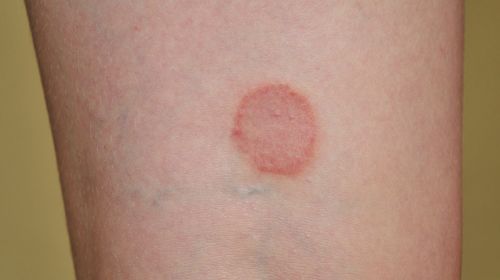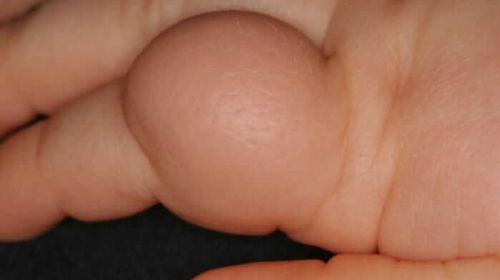A fire mark is a benign skin lesion that is innate. The nevus flammeus can appear anywhere on the body. Fire marks on the face are often particularly stressful for those affected. What is behind the stains and how to treat them.
- A fire mark is an innate, benign skin change.
- © iStock.com/greg801
The fire mark (nevus flammeus) is a benign malformation of the blood vessels in the skin. Depending on its location on the body, the dark red spot can indicate further malformations. Most of the time, the skin disease is harmless, but it does not resolve itself and can be removed by a doctor using a laser.
Article content at a glance:
Symptoms: what does a fire mark look like?
A fire mark occurs predominantly on one side of the face, neck or in the region of the tailbone. Sometimes a nevus flammeus also develops on the arm or leg. Over the years it becomes darker and darker, which is why it is also known as a port wine stain.
The stain is usually not visible at birth; the stain is usually visible to the naked eye only after a few weeks because the blood vessels slowly expand. At this stage, the fire mark is usually still pale red. With increasing age, the fire mark becomes larger and turns dark red, a bluish color is also possible. From around youth onwards, the growth of the malformed blood vessels can cause dark red-colored knots and nodules to form within the stain. As a result, the surface of the skin bulges slightly overall.
A special form of stork bite in the neck is common
The stork bite is a special form of the fire mark that occurs in many children. Characteristic is a delicate red, blurred spot on the neck, which can be five millimeters to ten centimeters in diameter. In contrast to the normal fire mark, the stork bite can spontaneously fade in the course of the first year of life. It is very inconspicuous, so that treatment is usually not necessary – no nodules or knots form within the stork bite, and malformations are not to be feared.
Causes of the formation of the nevus flammeus
So far, the exact reasons why a fire mark is created have not been clarified. Doctors assume that incorrectly formed blood vessels in the upper layers of the skin are responsible for the dark red spot: Because they lack the appropriate nerves, the blood vessels cannot contract and are permanently dilated. As a result, more blood is transported to the affected area of the skin, which is reflected in the reddish color. Fire marks are innate, but they are not inherited. When the red spot becomes visible differs from person to person: it often shows up after a few weeks of life, in other cases only after years.
Diagnosis of the fire mark
With a visual diagnosis, the doctor can determine the characteristic skin changes in the first few months of life. If in doubt, the doctor can take a tissue sample from the affected skin and have it examined under a microscope or in a laboratory. The also congenital blood sponge (hemangioma) can be used as a differential diagnosis in the event of a fire stain. In the first weeks of life, the fire mark and the benign tumor look very similar, but the blood sponge quickly becomes dark and raised. Therefore, children with unclear skin changes should be examined closely.
Why the location of the nevus flammeus is important
Since a fire mark can occur together with other malformations, it is important to examine the affected children:
On the eye (Sturge-Weber syndrome): If the fire mark appears on the forehead or upper eyelid, it can lead to glaucoma (glaucoma). Therefore, intraocular pressure should be monitored in such children. Since the blood vessels of the meninges are also affected by the nevus flammeus, the brain waves should be examined regularly.
In the sacrum area: If the fire mark occurs over the sacrum or in the area of the lumbar vertebrae, malformed blood vessels may also have developed in the lower section of the spinal cord.
Along the extremities (Klippel-Trénaunay syndrome): A fire mark running lengthways over the leg or arm means that the blood vessels in the subcutaneous fat tissue are also dilated. This is often visible on the leg through varicose veins. If blood vessels in muscles or bones are also affected, the affected arm or leg will grow faster than the other.
What treatment is there for the fire mark?
Treatment of the benign fire mark is not necessary in all cases. Rather, it depends on where the nevus has formed and whether it affects other parts of the body such as the eyes. Psychological stress from noticeable or large fire marks on the face can also make treatment necessary. Basically, the two options laser therapy and camouflage are available for treating the fire mark.
Laser treatment of the nevus flammeus
Laser therapy will lighten the stain, but it will not completely disappear. The affected area of skin is specifically treated with a dye laser; red structures absorb it in particular, which destroys the blood vessels contained in the stain. An integrated cooling system cools the surrounding skin for protection. Infants and young children are usually given general anesthesia because the treatment causes mild pain.
In the first few days after the treatment, the stain may initially turn darker in color until the body then removes the destroyed components. After about ten days, the fire mark will have faded. This requires four to six treatments at intervals of six to eight weeks. In rare cases, the laser treatment can lead to the formation of blisters, scabs or scars.
If the fire stain darkens over time, the laser treatment can be repeated. Basically, the success of the treatment depends on the depth and location of the stain.
Camouflage: Conceal fire stains with special make-up
Fire marks can also be covered with special make-up so that they are less noticeable. The camouflage is highly opaque make-up based on wax and oil – first, light green paint is applied to neutralize the red, then skin-colored. However, the application is time-consuming and sometimes does not achieve complete coverage.


